- V
- GF
- NS
- DF
- View Recipe Key
Shrimp Risotto with Peas
Shrimp Risotto with Peas
This colorful shrimp risotto gets its wonderful aroma from fennel, garlic, and lemon. This is an elegant dish that’s quick enough to pull together on a weeknight!
This post contains affiliate links. Full disclosure is at the bottom of the article.
Don’t you love it when you’ve got a craving for a specific dish and you just happen to have all the ingredients on hand to make it, like, now? This often happens to me with risotto, because I looooove risotto. I basically make it once a week, so I keep the following essential ingredients on hand at all times:
- Risotto rice
- Good-quality stock (chicken, vegetable, or seafood stock)
- Blocks of Parmigiano-Reggiano and Pecorino Romano cheeses.
With these three crucial risotto ingredients on hand, I can make a delicious risotto with whatever I have in the pantry, fridge, and freezer.
Got a head of cauliflower? Quickly broil the florets, then add lots of parmesan and some chili flakes, and you’ll end up with a comforting dish that would give the best mac & cheeses of the world a run for their money in terms of deliciousness.
Got fresh corn? Make it the central star in an all-corn risotto, or throw in some crab meat to make a truly special, elegant, spring dinner dish.
Got a big bunch of kale? Turn it into a colorful pesto, then swirl it into a cheesy risotto and top with walnuts for some crunch.
Lucky enough to have a basket of fresh, sweet, green peas on hand? Showcase them in a deliciously vegetarian green pea risotto, or combine them with juicy shrimp to create a colorful dish that’s quick and easy enough to be pulled together on a weeknight.
The flavors in this shrimp risotto get an aromatic boost from fennel seeds, garlic, and lemon, while the green peas add a pop of color! The sprinkle of dill makes the dish taste super fresh. This risotto comes together in a snap, especially if you happen to have cooked shrimp and shelled peas in the freezer, but it offers surprisingly complex flavors and an irresistible combination of textures—from the tender shrimp, to the slightly crunchy peas, to the cheesy, gooey rice.
This shrimp risotto is undoubtedly elegant enough to be served to company, but I truly encourage you to make it on a weeknight. This dish might just be the most delicious reward after a long day at the office—or wherever work is for you. You deserve it!
Helpful Tips for Making Shrimp Risotto with Peas
My golden risotto-making rule: The very best ingredients make the very best risotto
As is often the case with simple, Italian-inspired dishes, using the very best ingredients you can get your hands on or afford makes the biggest difference in terms of the flavor of your final dish. In this shrimp risotto, I encourage you to try to find homemade fish or seafood stock at your local fishmonger, they often keep it in the freezer section. Homemade stock will impart a milder flavor to the risotto instead of stealing the spotlight, which I find canned fish or seafood stock tends to do. If you do use canned stock, I recommend diluting it 2/3 stock to 1/3 water. This will soften the flavors and leave centerstage to your main risotto ingredients.
Also, use quality risotto rice for the creamiest texture—Arborio, Carnaroli, or Vialone Nano are all good picks. Finally, make sure to hunt down Pecorino Romano cheese for this recipe: it’s a super flavorful cheese and you need just a bit to round up the delicious aromas of this shrimp risotto.
Using Cheese in seafood dishes: yay or nay?
Italians often say cheese should never touch seafood dishes. In Italy, for example, you will never be served cheese over seafood pasta. In this shrimp risotto, though, I think a little Pecorino-Romano cheese adds a truly lovely creaminess to the dish, and some depth of flavor too. I think it’s worth bending the rule here, but in the end, it’s your choice! This shrimp risotto would also be perfectly delicious sans cheese.
Here’s the type of cheese I think you should use in this shrimp risotto
Parmigiano-Reggiano cheese is often used in risotto recipes, but in shrimp risotto, I like to use Pecorino Romano cheese instead. Pecorino Romano is a hard Italian cheese made with sheep’s milk. It has a sharp, slightly peppery flavor and it’s super aromatic, which means it’s just the thing to balance out the mild, sweet flavor of shrimp and peas. Be aware that Pecorino Romano is quite salty, in fact, it’s saltier than Parmigiano-Reggiano, so you’ll need to use less to provide flavor and creaminess to the dish. Make sure to wait until you’ve stirred in the Pecorino Romano cheese into the risotto before adding any salt to the recipe; depending on the cheese, you might not need to season the risotto at all.
Photo: Consorzio per la tutela de Pecorino Romano
More about the different shrimp varieties you can use in this shrimp risotto
This shrimp risotto comes together in a flash when you use precooked, frozen shrimp. I like to use tiny Northern shrimp (also called Northern prawns) because they’re tiny and sweet and defrost in no time. You can also use pink shrimp, which exist in many different sizes. Tiny pink shrimp (61 to 70 count per pound) are handy because they, too, defrost very quickly, but you can use larger shrimp and cut them into bite sizes before you stir them into the risotto.
Of course, you can also use raw shrimp: simply peel them and sauté them in a bit of butter for a couple of minutes before adding them to the risotto. Be careful not to overcook the shrimp because the heat from the risotto will cook them further.
How to Scale Up this shrimp risotto recipe to serve more guests
Most risotto recipes serve 4 to 6, with ingredient quantities that are hard to split into halves or thirds. This has always annoyed me because I usually make risotto for 2 people. So I’m writing all my risotto recipes to serve 2, which means the math is easier to scale up the ingredients to serve 4 or 6 guests. Note that this shrimp risotto recipe produces a generous 2-serving yield—you could stretch it to 3 servings if this dish is part of a more elaborate menu that includes appetizers and sides.
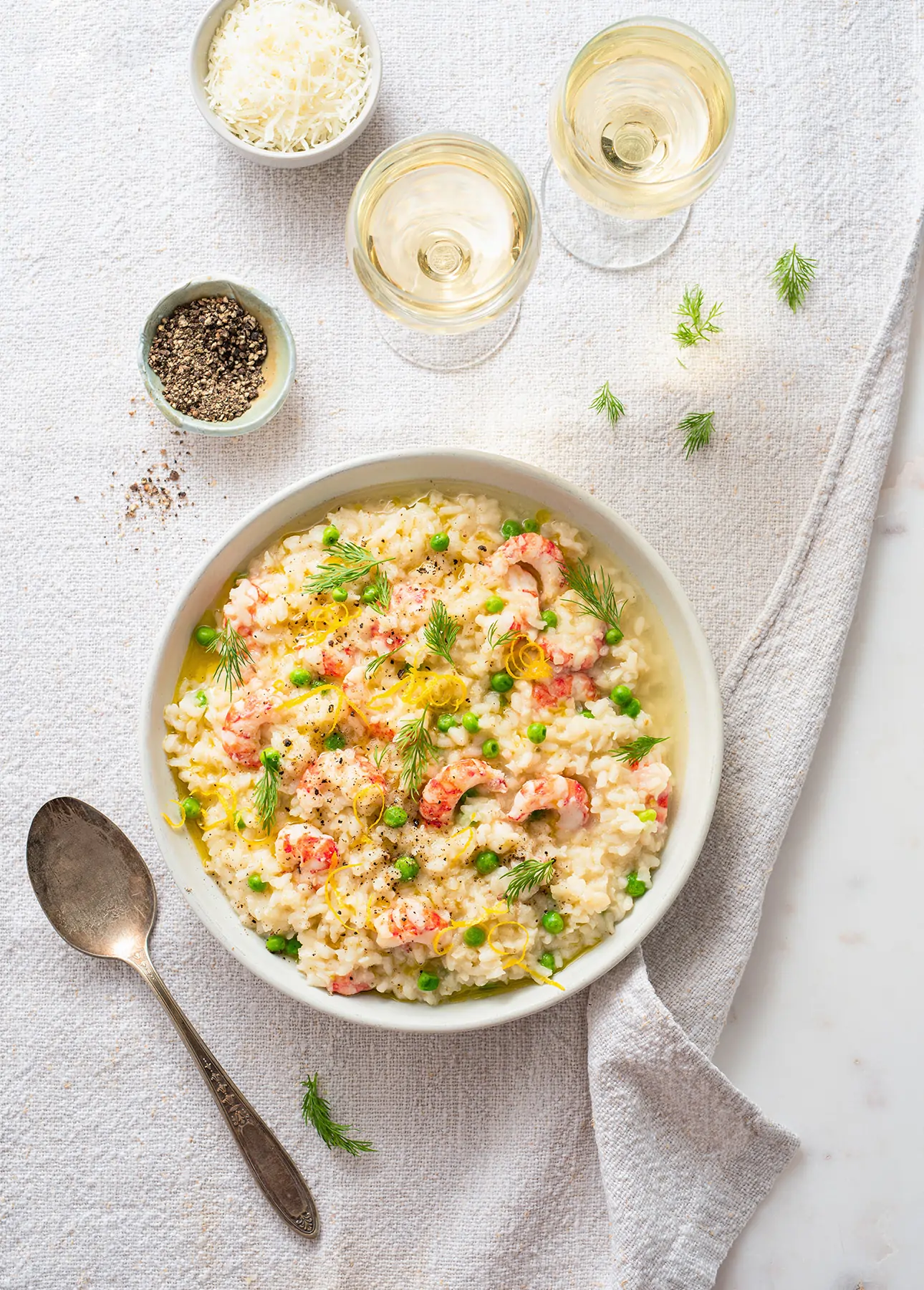
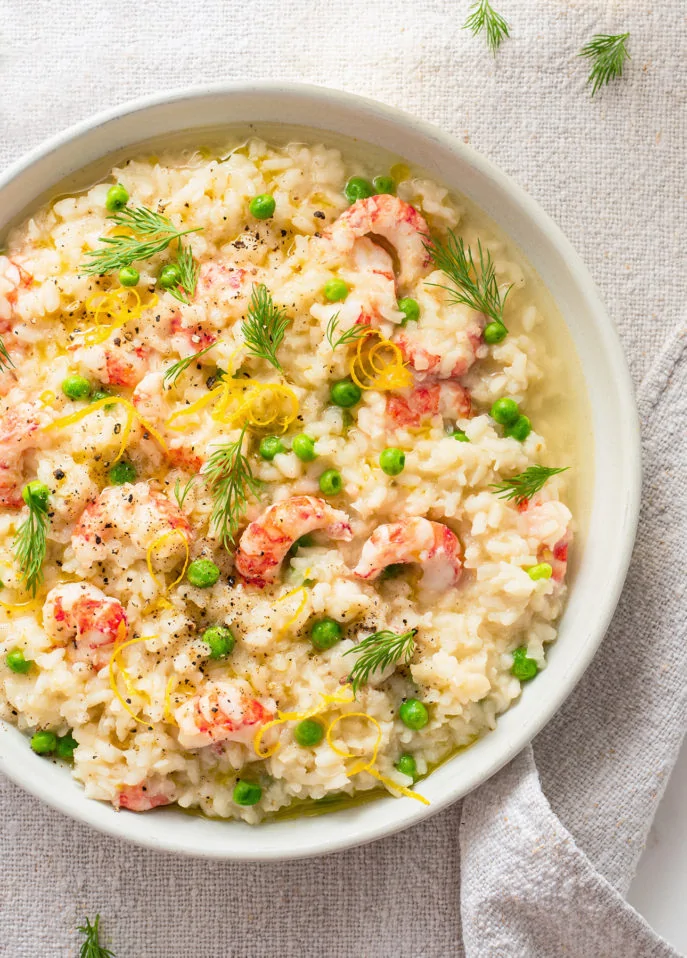
Shrimp Risotto with Peas
Ingredients
For the Shrimp Risotto
- 2 ¾ cups fish or seafood stock (see note)
- 1 tbsp butter
- 1 tbsp extra-virgin olive oil
- 1 shallot, minced, or substitute ¼ cup (60 ml) minced onion
- 1 clove garlic, minced
- ½ tsp crushed fennel seeds
- 5 oz risotto rice, such as Arborio, Carnaroli, or Vialone Nano
- ½ cup dry white wine, such as Pinot Grigio
- ½ cup frozen peas, thawed, or shelled fresh peas
- ½ lb cooked small shrimp
- 1 oz finely grated Pecorino Romano cheese
- Finely grated zest and juice from ½ lemon (about 1 tsp/5 ml zest and 2 tbsp/30 ml juice)
To Serve
- Fresh dill leaves
- Extra-virgin olive oil
- Freshly ground black pepper
Instructions
- In a small saucepan, bring the stock to a simmer, then keep warm over low heat.
- In a large saute pan or a cast-iron braiser set over medium-low heat, melt the butter in the olive oil. Add the shallot and cook, stirring, until soft, 3 to 4 minutes.
- Add the garlic, crushed fennel seeds, and risotto rice and stir for 2 minutes, until the grains are translucent around the edges. Add the wine and stir vigorously while the wine is bubbling up, scraping down the bottom of the pan to loosen the caramelized bits. Simmer until the wine is fully absorbed.
- Add 1 ladleful of the stock and simmer, stirring from time to time, until the stock is almost completely absorbed.
- Continue adding broth, one ladleful at a time, allowing each ladle to be absorbed before adding more. When there's about 1 cup (250 ml) stock left, stir in the peas and stir to incorporate. Add ½ cup (125 ml) broth, stir and keep cooking until the broth is almost fully absorbed.
- Add the grated Pecorino-Romano cheese and stir until the cheese is fully melted and incorporated. Stir in the shrimp, lemon zest and juice, then season with black pepper. Taste the risotto, and season with salt if needed. Stir in the remaining broth.The risotto should now be loose and super creamy. Cover and turn off the heat. The risotto can stand for about 5 minutes but should be served as soon as possible for the best texture.
- SERVING: Serve the shrimp risotto in warm bowls, then garnish each serving with a drizzle of flavorful extra-virgin olive oil, a sprinkle of fresh dill leaves, and some freshly ground black pepper.
- STORAGE: This shrimp risotto is best enjoyed within minutes of being made. If you do have leftovers, refrigerate in an airtight container for up to 2 days. To reheat, transfer to a nonstick skillet, add a couple tablespoonfuls of broth or water and warm up over medium-low until the risotto is loose and hot. Serve immediately.
- NOTE: Fish or seafood stock is perfect for fish or seafood-based risotto because its rich aromas underlines the flavors of the fresh produce from the sea. The best fish and seafood stocks are frozen when freshly made: ask your local fishmonger, chances are they have some in the freezer.You will also find seafood stock in the soup aisle, sold in tetrapaks, just as chicken stock is.
Did you make this?
Tell me how you liked it! Leave a comment or take a picture and tag it with @foodnouveau on Instagram.
Disclosure Notice: This site is a participant in the Amazon Associates Program, an affiliate advertising program designed to provide a means for the site to earn fees by linking to Amazon and affiliated sites.
If you click on an affiliate link, I may earn advertising or referral fees if you make a purchase through such links, at no extra cost to you. This helps me create new content for the blog–so thank you! Learn more about advertising on this site by reading my Disclosure Policy.
Author: Marie Asselin

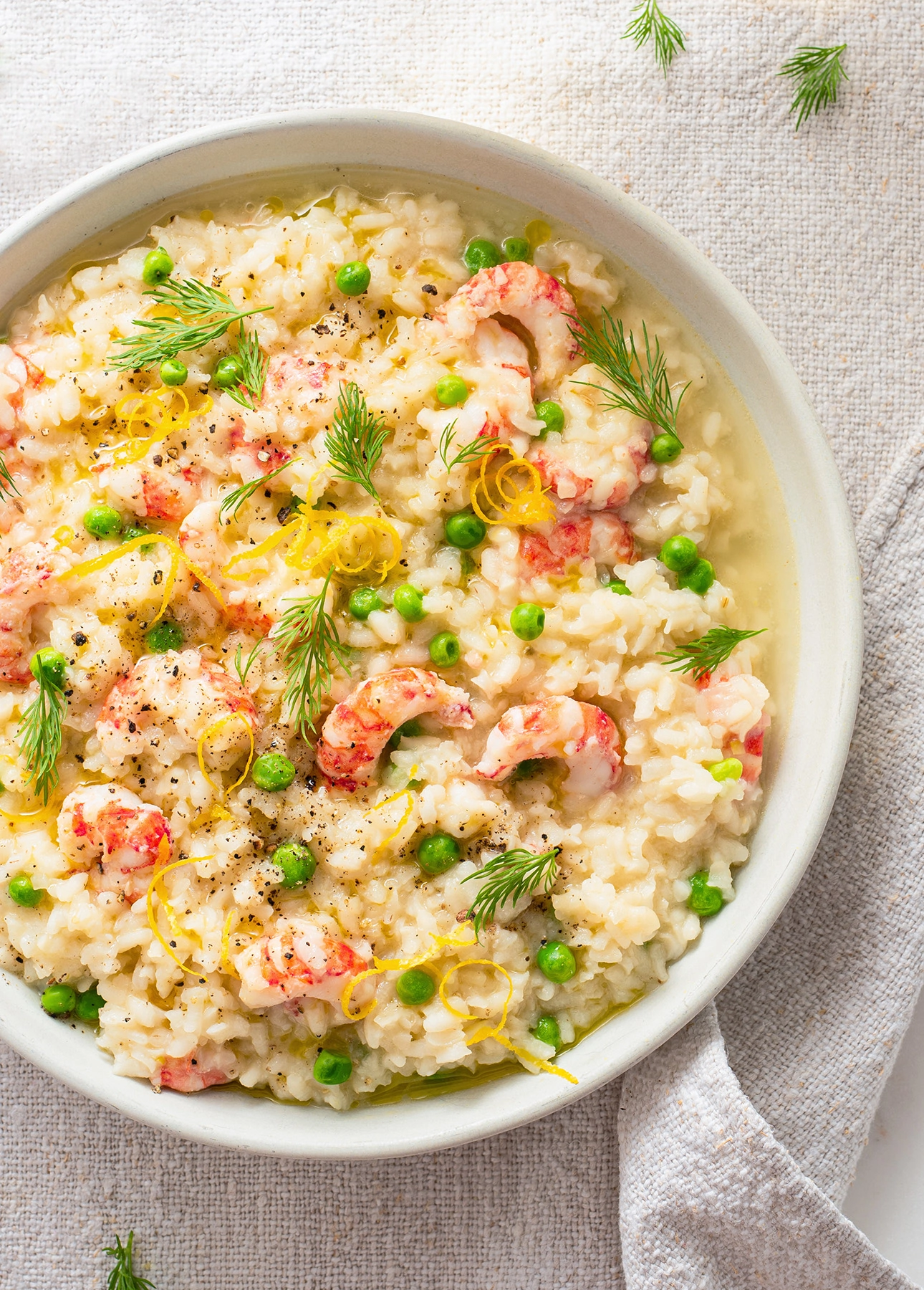
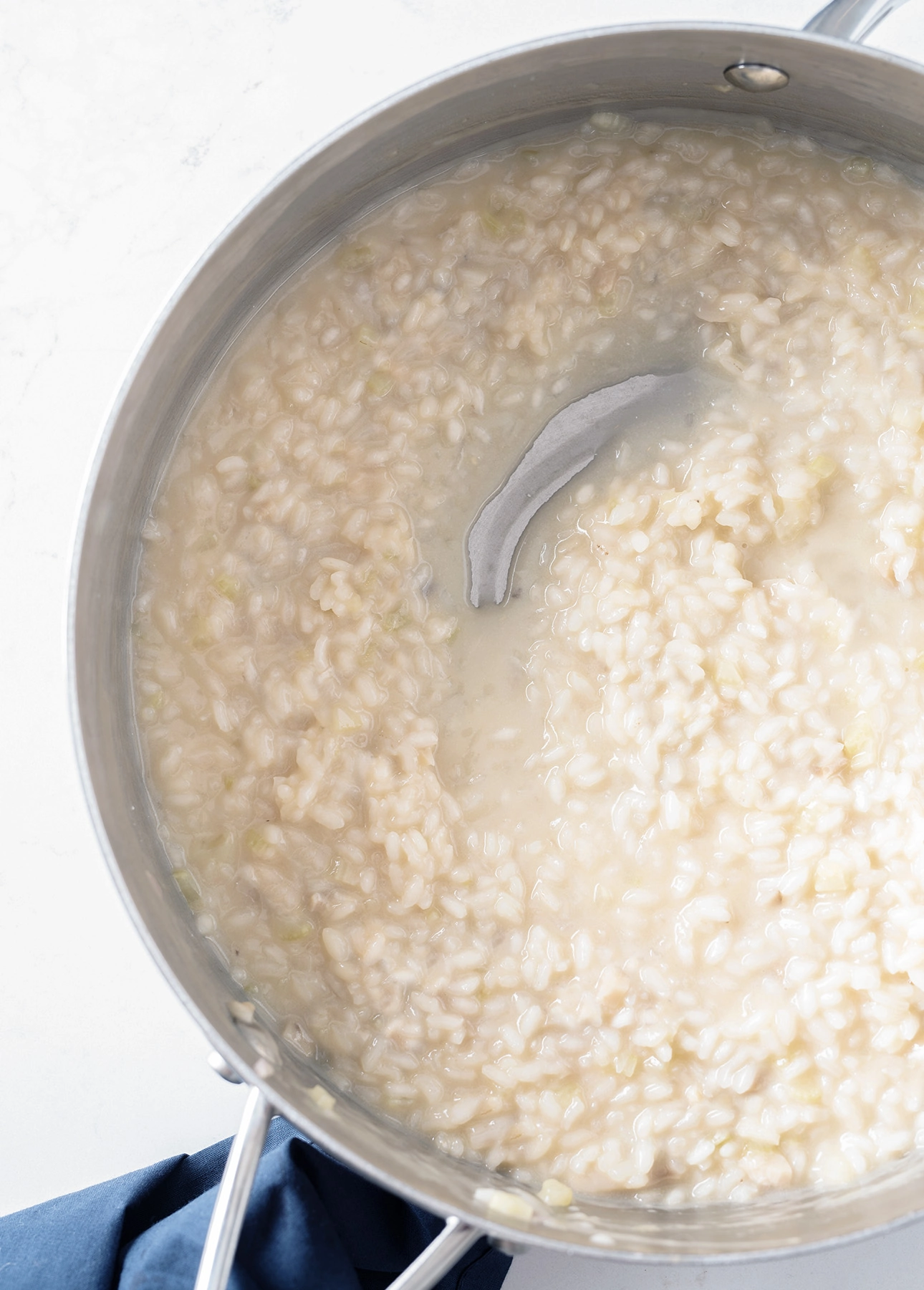
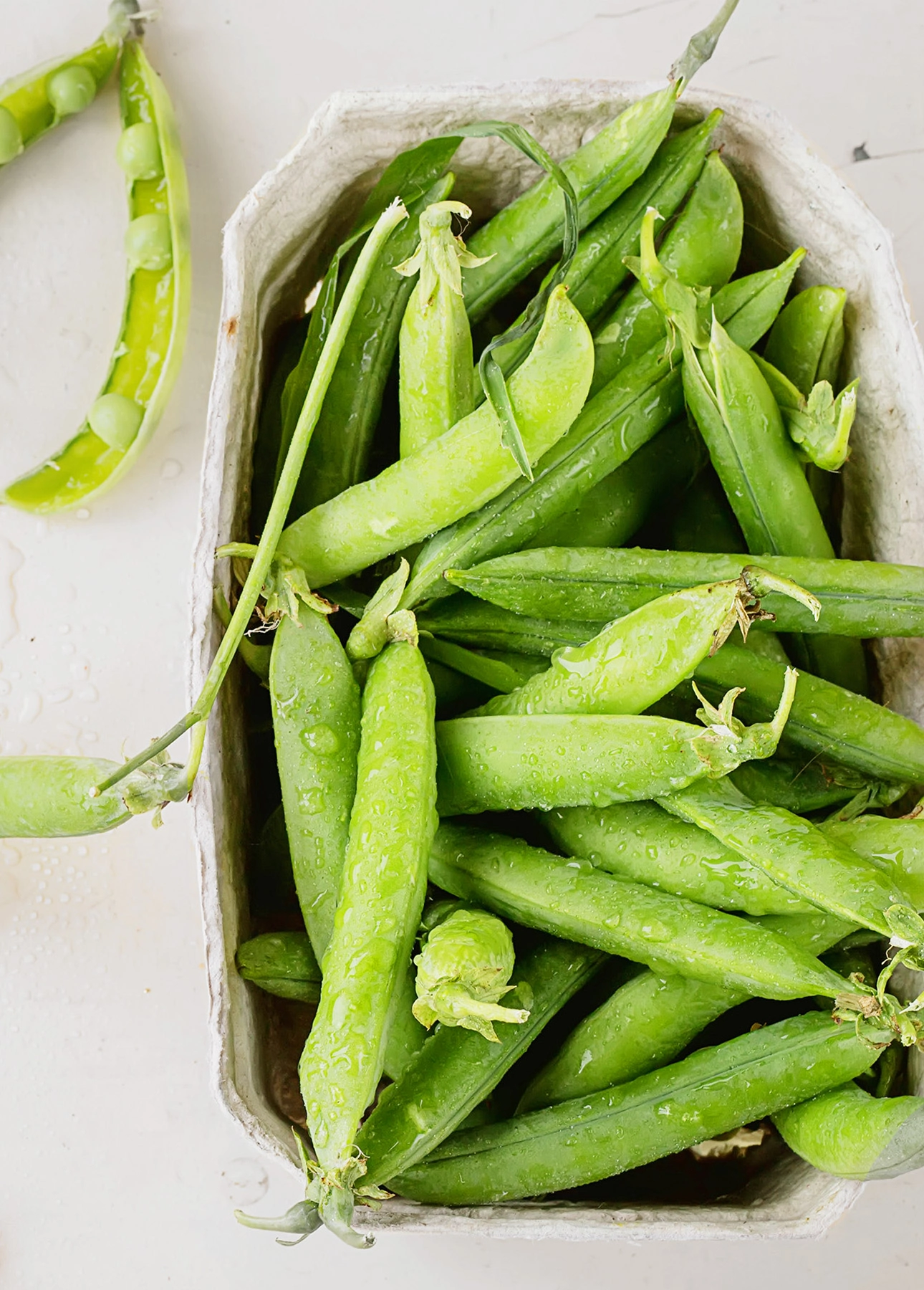
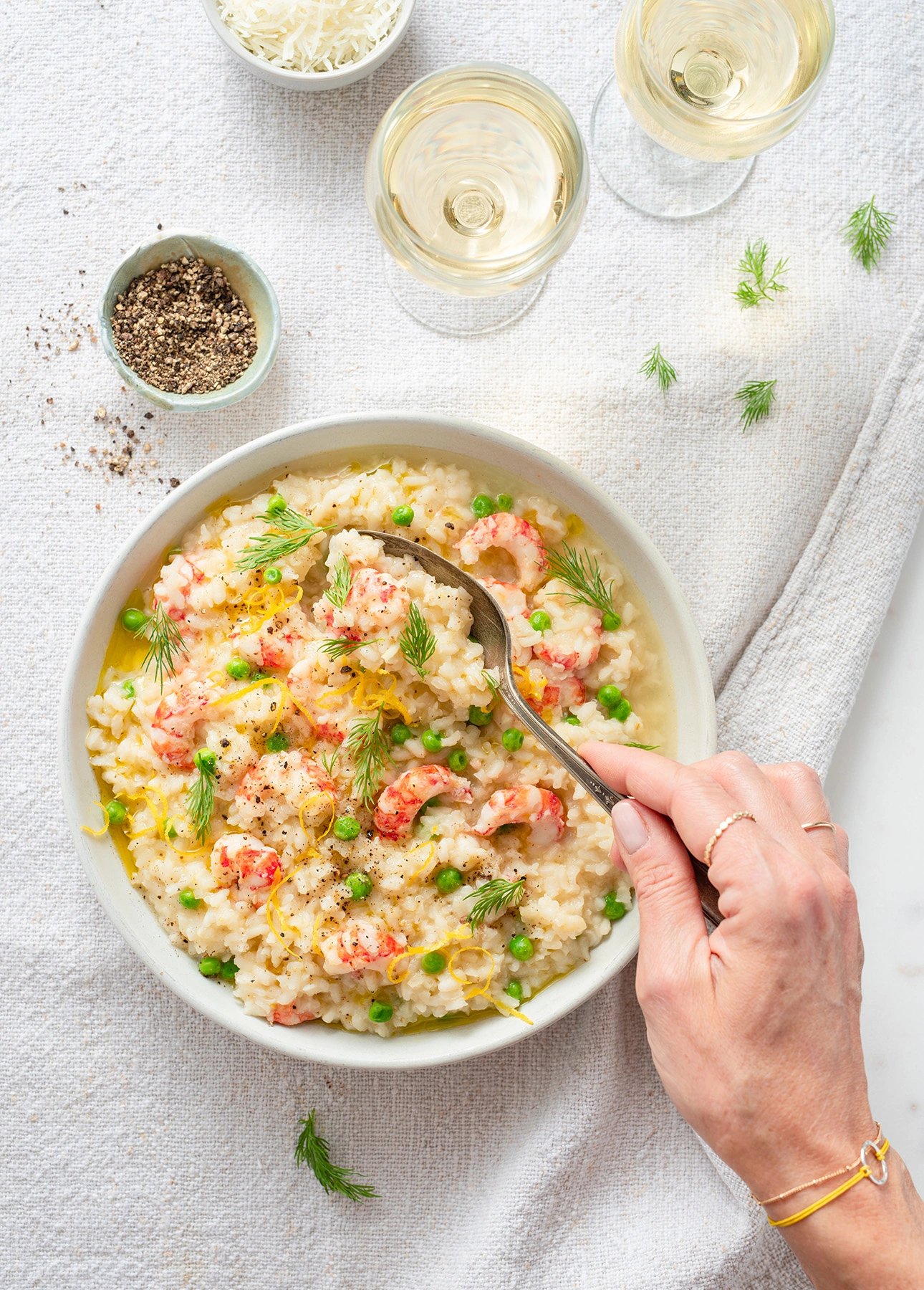
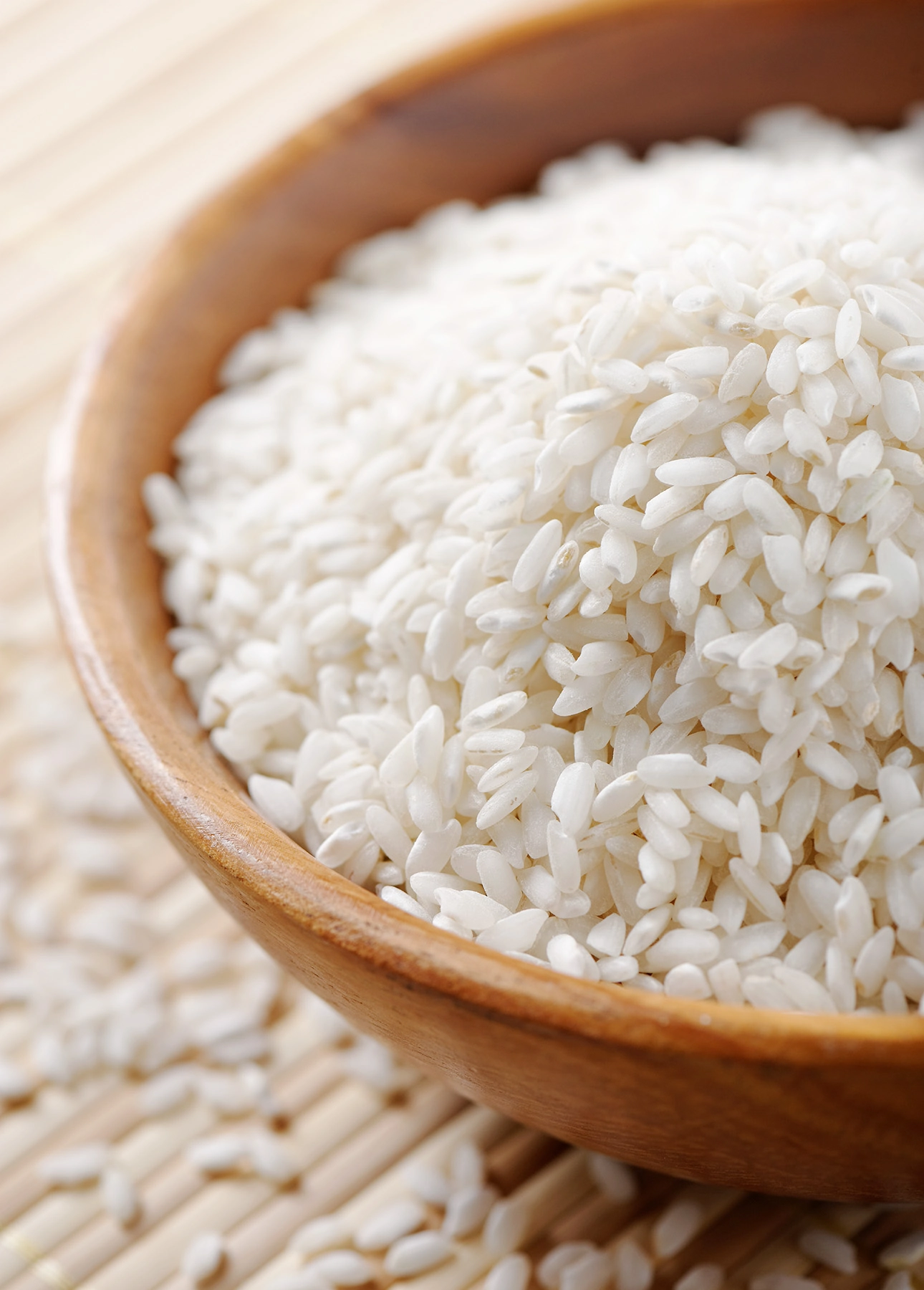
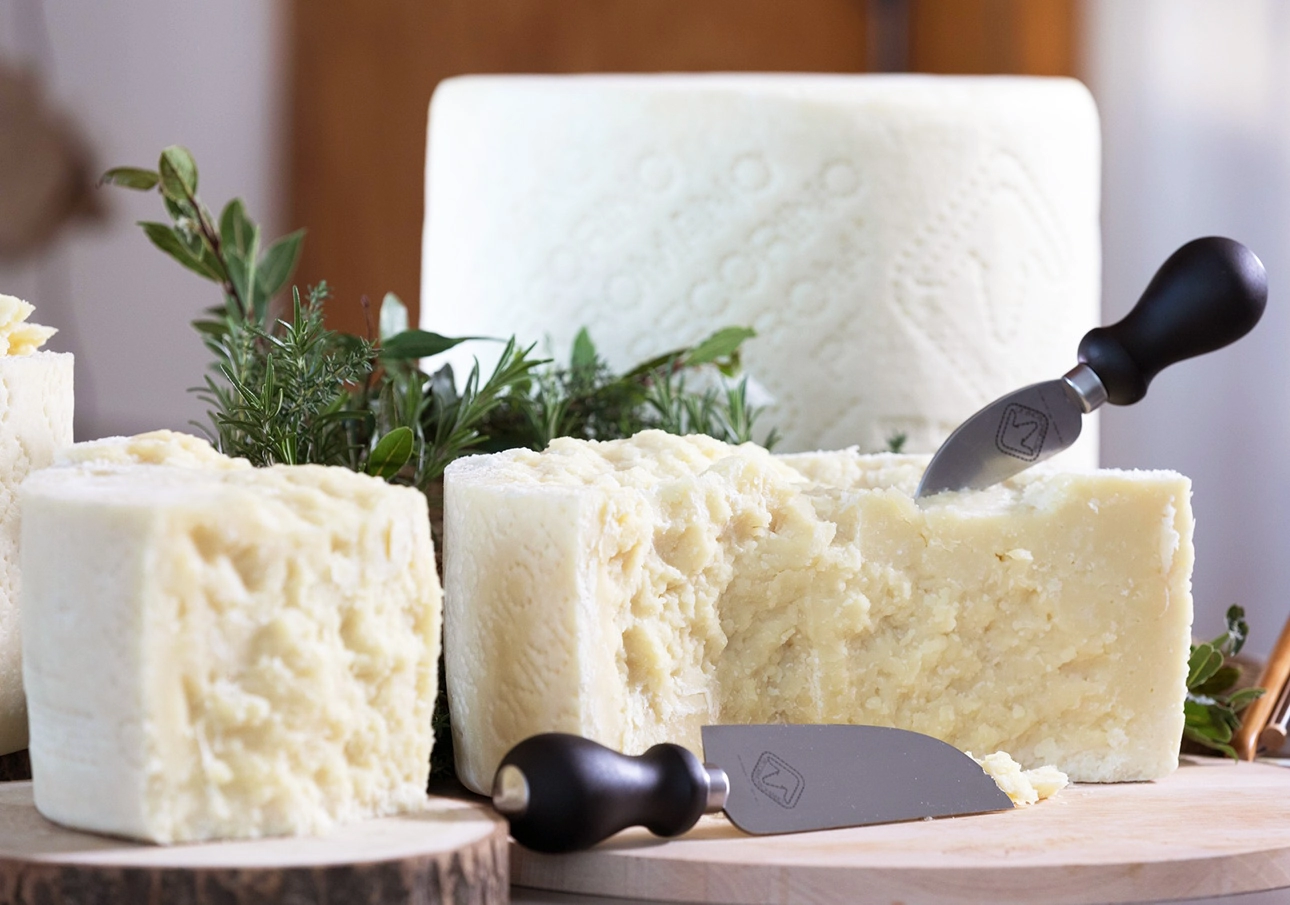

I wanted a simple recipe to make shrimp risotto and it hit the mark, and crushed it with flavor! Love the vibrant flavors and the richness added by the seafood stock. Definitely a keeper. Bravo
This risotto definitely highlights the beautiful flavor of fresh shrimp. I think using fish or seafood stocks makes a big difference! Happy you enjoyed the dish.
Just did the recipe, one to one as in the instructions: excellent, fresh and delicious! 100% recommended
So happy you loved it Dayana! This is one of my favorite risotto recipes, too. It’s so flavorful and satisfying!
A lovely recipe: good balance of flavors. I subbed asparagus for peas (my wife hates peas). With leftover risotto, I cool it then make risotto cakes. They keep well, and come out as something completely different from risotto.
Asparagus and shrimp are absolutely perfect together, great substitution! Happy you enjoyed the risotto William!
This shrimp risotto was so perfect! I was a little intimidated about making risotto but your instructions explained it so well.
You just need a few key tips to make perfect risotto! Once you’ve got them down, you’re on for a lifetime of deliciousness 😍
Gorgeous dish for spring. I love the addition of shrimp to make this heartier for a light warm weather meal. This on the patio watching the sun go down is my idea of heaven.
What a wonderful image! Sounds like my idea of heaven, too 😍
This dish looks wonderful! I have been looking for new recipes for some shrimp, as that seems to be a go to for us in the summer.
A lot of people think of risotto as a dish to serve during cooler seasons, but I love it in the summer, too! All you need to do is adapt the flavors to make risotto any-season friendly!
This shrimp risotto recipe is an excellent dish! I also want to give you props for your photography! You have some gorgeous photos on your site!
Thank you so much Leslie! The comment means a lot coming from you. I love your site as well!
This shrimp risotto was exactly what I was craving! It was such a hit and it was easy to make. It was loaded with so much flavor that complimented the shrimp so perfectly!
Thanks Kathryn, that’s so great to hear! This is an incredibly flavorful risotto indeed. Once of my favorites to make!
Any time we can add green vegetables to a meal it’s a good thing. Thanks for sharing this yummy recipe.
Happy to be the provider of green-friendly recipes 💚😉
I agree that grated romano cheese is always is a good touch with pasta and seafood and most definitely risotto! Your recipe was easy to make and so very very delicious! thanks for sharing it.
Thanks Dennis! I always thought of Pecorino Romano as a seasoning tool. It adds such depth to dish, even when you use just a little!